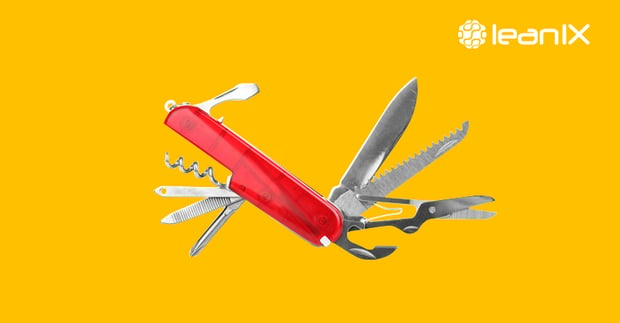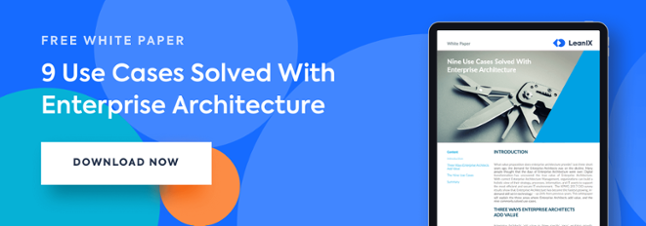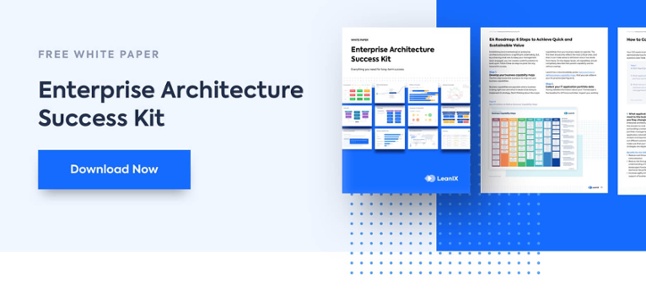
In a previous post, we highlighted three use cases solved with Enterprise Architecture: Integration Architecture, Technology Obsolescence, and Data Compliance. For a full overview of these Enterprise Architecture use cases, and specialized EA tools may help, see this post: 9 Use Cases Solved With Enterprise Architecture: Part Two
This third and final installment of the 9 uses cases solved with Enterprise Architecture; we highlight the following four use-cases: Standards Governance, Monolith to Microservices, Cloud Transformation, and IoT Architecture.
THE NINE USE CASES continued
6. Standards Governance
Overview of use case
The use of standardized information technology in large corporations has measurable benefits: reduced training time and costs, lower support and maintenance costs, better bargaining power with a smaller number of vendors, and enhanced communication.
Standardization often goes hand in hand with centralization, the process of giving your IT department more control over purchases of hardware and software, as every new piece of software equipment you add to your IT arsenal can require installation, maintenance, staff training, repair, patches, upgrades, etc.
Standardization can have its drawbacks as well, as technologies change very quickly, and processes need to be updated when technology is updated. To stave off killing innovation, companies also use alternative concepts, like radical agility. Radical agility, a term coined by LeanIX customer, Zalando, is an architectural concept that builds on a service-oriented architecture. This method allows engineers to get work done while management gets out of the way. The radical agility approach is based on three pillars: autonomy, mastery, and purpose, all bound by organizational trust rather than command and control. Being open and adaptive to new technologies is crucial to both your organization’s mission and its ability to operate efficiently. Similarly, being flexible when it comes to individual preferences — whether it is working on a specific platform or using a particular spam filter — can help employees work better and encourage creativity.
For these reasons, it is important to adopt a standardization policy that fits your situation and needs. How can enterprises improve good governance while staying agile simultaneously? LeanIX can help steer you in the right direction.
How EA and LeanIX can help
LeanIX can help you to document your technology standards in a transparent  and efficient manner. First, it is important to create company-wide standards and make them accessible. Then, identify the use of non-standard technologies. Find out why these technologies have an exceptional usage. From there, plan standardization guidelines that best fit your company.
and efficient manner. First, it is important to create company-wide standards and make them accessible. Then, identify the use of non-standard technologies. Find out why these technologies have an exceptional usage. From there, plan standardization guidelines that best fit your company.
In the LeanIX software, you are able to note important information for each technology in an organized manner:
- Create IT component Fact Sheets for every standard with a defined lifecycle, and add a “standard” tag
- Set a successor in the case of outdated technology
- Define a Tag Group for all with a necessary Standard status (e.g., leading technology, exceptional use, sunset)
- Add a “Standard” Status Tag to each standard IT Component Fact Sheet
- Create a Technology Stack for the whole list of standards (e.g., databases, application servers, methods)
- In combination with an ITSM solution, like ServiceNow, Enterprise Architects can make sure that only standard technologies that are overseen by the EA are deployed
Of course, LeanIX also supports the concept of a radical agility architecture. LeanIX allows you to plan and manage a service-oriented architecture, such as microservices; see the microservices use case. For the concept of radical agility to work, standardized interfaces are needed. Their management is also a key strength of LeanIX; see the integration architecture use case.
7. Monolith to Microservices
Overview of use case
Rapidly accelerating digitalization is forcing many businesses to rethink their architectures. To meet the constantly growing expectations of technology-savvy customers, companies must ensure that their products are available on all digital channels and as quickly as possible.
Over time, monoliths develop very complex structures that make it increasingly difficult to perform changes quickly. Moreover, scaling cannot be limited to individual parts but must be applied to the entire application. One way to reduce throughput times is to introduce a microservices architecture in software development.
Microservices break down monoliths, which allows for rapid changes and short release times along with high scalability and autonomous teams. Companies that use microservices deploy new software releases five times faster than those that do not use microservices.
However, even companies that have adopted microservices still have the same hurdles as companies that have not adopted them - legacy issues and missing information does not get easier.
How EA and LeanIX can help
In a microservices organization, state-of-the-art EAM can create more added value than ever. Although it is not always easy for companies to introduce microservices, there are excellent reasons to do so. Allan Naim, Product Manager Container Engine and Kubernetes at Google, predicts that in the not-too-distant future, every organization, no matter the industry or sector, will become a software company. Customer data is becoming as valuable as products and services.
LeanIX forms the link between the individual teams and technologies and provides an overall view of the system. LeanIX software offers all employees up-to-date access to information on the IT landscape in their personal context, which is a basic requirement if a microservices architecture is to work.
As a single instance of truth, all important information about the microservice can be stored in LeanIX in an Application Fact Sheet. Dependencies are reflected as IT Components and will be automatically linked to the Application Fact Sheet. This allows you to automatically transfer the information from development environments into the LeanIX repository, and enjoy a holistic overview of the microservice landscape.
8. Cloud Transformation 
Overview of use case
Cloud paves the way for new service-driven business models, which in turn create high business value and unprecedented levels of customer satisfaction. Cloud computing has the potential to bring many benefits including cost-savings, efficiency improvements, increased time to market, shortened development cycles, and the ability to scale at demand. Enterprises can also dramatically improve asset utilization, reduce operational expenses, and redefine IT staff relationships after moving to the cloud.
Gartner analysts believe that by 2020 a “no-cloud” policy will be just as rare as a “no-internet” policy is today. Unfortunately, often companies do not know how to set up their cloud endeavors.
Cloud has become a key determinant of IT and business strategy. Over 60% of companies are planning to heavily intensify the usage of cloud solutions. However, complex business landscapes and rapidly changing infrastructure pose a serious obstacle to mastering cloud transformation.
To successfully move to the cloud, major organizational, operational, and technical modifications are required. Numerous influencing constraints occur along the way, including budget limits, need of exponential scale, growing complexity in company policies and external regulations. Enterprise Architects need to be able to implement a roadmap from legacy infrastructure to cloud.
How can EA and LeanIX help?
LeanIX software will also help you govern and improve your cloud endeavors. Enterprise Architects are in the best position to evaluate the organization’s cloud readiness. Cloud transformation concerns the transformation of the entire business model and presents a new way of working.
Enterprise Architects, as a first step, evaluate cloud readiness ask the following questions: Is the current status mostly on-premise IT? Are some services already outsourced? Is DevOps in use? Do the capabilities to manage private, public, and hybrid clouds exist?
From here, Enterprise Architects may design the target cloud architecture for their prospective companies. For a successful cloud transformation, a wide variety of factors should be considered: current and future capabilities, the application portfolio strategy, operational and organizational questions related to people and processes, as well as cost metrics.
With the help of LeanIX software, Enterprise Architects can define target capabilities, decide which applications will move to the cloud, and which applications should stay on internal databases.
LeanIX has helped many companies transfer their appropriate applications to the cloud. Our software will prompt you to answer and record dire questions to prepare for cloud transformation.
9. IoT Architectures
Overview of use case
Gartner reports that 20.4 billion connected “Things” will be in use by 2020. While the world finds space in their personal lives and homes for smart accessories, Enterprise Architects should look into how the Internet of Things (IoT) can benefit their organizations. IoT brings shorter times to market, provides real-time Big Data insights, enables new services and business models, and reduces cost. With all of the potential, there are also five significant challenges that face the IoT:
Security
With data breaches occurring almost weekly, security is a crucial issue and proves to be a significant challenge for the IoT. Poorly designed devices can expose a user’s data to theft, harm their personal safety, and pose a significant risk for rights violations.
Privacy
The United States Federal Trade Commission has outlined a list of concerns about the security and privacy of connected and embedded devices. The FTC went on record acknowledging that IoT devices are capable of collecting, transmitting, and sharing highly sensitive information.
Standards and regulations
As a brand-new technology framework, the IoT world has a lack of set standards. This lack of documented standards leaves the door open for inappropriate behavior by IoT devices.
Integrations
Gartner research analysts claim that “through 2018, half the cost of implementing IoT solutions will be spent integrating various IoT components with each other and back-end systems. It is vital to understand integration is a crucial IoT competency.”
Complexity
Adapting to a different IT architecture can prove to be difficult. Having an IoT roadmap will keep you from adding valueless technology to your landscape.
How EA and LeanIX can help
In this digital age, progressive companies are looking for ways to manage risk, not to avoid it altogether. Enterprise Architecture can directly contribute to a beneficial IoT roadmap by managing the risks through defining relevant business capabilities; defining the scope of retirements and new applications; ensuring the proper interoperability of applications; driving and tracking transformation progress in projects, eliminating security risks; and establishing relevant data for future business decisions.
A Business Capability map provides the basis for creating a clear business and IT alignment. Business Capability maps help to define a list of priorities for application support, draw a common language between business and IT, and relate IoT requirements to existing business capabilities. With the LeanIX business capability map, Enterprise Architects can identify the current applications supporting the IoT capabilities, detect gaps in the application support, evaluate the quality of capability support based on defined criteria, develop requirements for existing applications, and identify the need for enhancements or new applications.
With the help of LeanIX software, Enterprise Architects can:
- Identify conflicts in requirements between different projects regarding the same applications,
- Plan and track application transformation (phase-ins of new applications and retirements of legacy applications)
- Build future scenarios for the application landscape
- Evaluate technology risk for applications and business capabilities based on the underlying IT components
- Identify the IT components to be replaced in order to mitigate security risks.
IN CONCLUSION
As digital transformation makes business more complex, it is important to rely on a professional EAM tool to support your business endeavors. Using self-made tools like Excel and PowerPoint are initially attractive because of the low start-up cost, ease of use, and minimal training required due to their familiarity, but they pale in comparison with using a specialized EAM tool. Enterprise Architects can utilize LeanIX to solve the most common use cases and bring measurable value to their organizations. LeanIX has helped enterprises gain transparency in their application landscape, save millions in cost, and avoid costly compliance penalties.

![Microservices — What an Enterprise Architect Needs to Know [White Paper]: How to transform from a monolith to a microservices architecture with enterprise architecture – including best practices for introducing microservices »](https://no-cache.hubspot.com/cta/default/2570476/1dc0f608-ad6c-4b01-bcef-88abd0c8d2c9.png)
![How Enterprise Architecture Management Paves the Way Into the Cloud [White Paper]:Evaluate Cloud Readiness, design the target Cloud architecture, implement the Cloud transformation and learn how to govern and improve everything once it is in place with a lean enterprise architecture tool. »](https://no-cache.hubspot.com/cta/default/2570476/c55901fa-d59d-417e-b4ac-641e2ce8d881.png)

.png?width=140&height=107&name=BTMPlaybook-FI%20(1).png)

